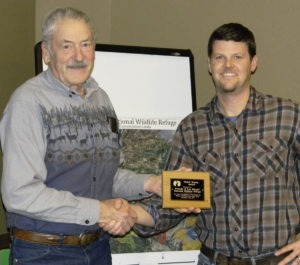
By Michael Howell
After being banned by the U.S. Fish and Wildlife Service from making any direct contributions of money or labor to the Lee Metcalf National Wildlife Refuge, the non-profit organization Friends of the Lee Metcalf National Wildlife Refuge looked for ways to spend their time, energy and money that could still benefit the Refuge indirectly. What they landed on in 2011 was a deal with the Bitterroot Land Trust. They recognized that the two organizations shared common conservation goals on private lands that benefit the Refuge.
The Bitterroot Land Trust had already made significant progress in establishing conservation easements in areas near the Refuge, most notably in the Burnt Fork drainage. It was obvious to both groups that preserving private lands adjacent to or in the vicinity of the Refuge provides numerous conservation benefits to the Refuge including wildlife connectivity, water quality, open space, scenic values, and a working agricultural heritage.
In the big picture, with several streams running through a mostly agricultural drainage that flows right into the Refuge, the Burnt Fork represents one of the best existing wildlife corridors from the Sapphire mountain range down to the river bottom.
The Friends of the Refuge gave the Bitterroot Land Trust their first donation of $10,000 in November, 2011 to boost the Land Trust’s efforts in the area of the Refuge. The money was used to pay for staff time to work with private landowners in the area to establish easements that would protect all the values associated with the Refuge. It could be spent on project planning, site inspection or evaluation, drafting of conservation easements, or gathering baseline documentation or other project costs incurred for those purposes.
The Friends have continued to donate regularly to the Land Trust, contributing a total of $50,000 through 2014. Another $15,000 was given to the Land Trust at last week’s meeting after hearing an impressive summation of accomplishments in establishing conservation easements in the Burnt Fork by BLT Director Gavin Ricklefs.
Ricklefs described how the Land Trust helped orchestrate the establishment of $3.9 million worth of conservation easement values in the Burnt Fork on a total of 27 separate parcels of land covering 1,400 acres. The landowners themselves contributed about $1.8 million of that value. The county’s Open Lands Bond program contributed $860,000 and about $1.2 million came from the federal Farm Bill program, a fund for preserving farms and ranches.
The Bitterroot Land Trust recognized the Friends of the Refuge for their longtime support by awarding them the Fletcher Newby Award. The award, given out annually since 2002, is named in honor of Fletcher Newby, an early board member of the BLT.
Newby started working for the Department of Fish and Game in 1951 (now the Montana Department of Fish, Wildlife and Parks). Then he became the first Executive Director of the Montana Environmental Quality Council. He went back to work for FWP in 1974 as Deputy Director and continued to work in that position until he retired in 1981. After retiring he and his wife Elaine moved to the Bitterroot Valley where he joined the board of the BLT. He did all the baseline studies required for placing a conservation easement on properties for the first five years of the organization’s existence.